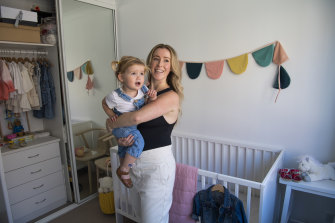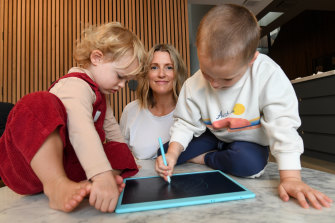Before her daughter Ellery was born, Ally Dowling had never heard of the term "destash". But in the children's clothing resale market, "destashing" – the process of clearing out bulk lots – is huge.
Unlike adults, who may offload clothing through resale or donation each season or when they tire of something, parents are often forced to upgrade entire wardrobes each time their little one has a growth spurt or one too many run-ins with a tube of paint at daycare.
Less is more: Ally Dowling with daughter Ellery at their Sydney home.Credit:Louise Kennerley
Dowling, a Sydney-based public relations executive, is part of a growing community of parents who are "slowing" their consumption of children's clothing, in line with making more considered choices when it comes to their own wardrobes. She eschews shopping centres and buys most of her daughter's clothes online, and a lot of it secondhand.
"Having a child, it takes a while to cotton on to the volume of clothes they go through in each age group," Dowling says. "Ellery stuck around a size 1 for quite a while. It wasn’t until that age I was conscious of buying things that weren’t necessarily new. I was happy with secondhand items that were in a good condition. I started looking where clothes could end up after that."
Dowling eventually fell into a Facebook group that specialises in reselling so-called "Instagram brands" and other hard-to-find labels – you won't find any Cotton On, Seed or other mainstream brands here.
Items by some labels, such as Millk and Jamie Kay, are so coveted, they can sell for $80 to $100 above retail, even after they have been worn, Dowling says.
Alana Tiller with her children Judson, 4, and Lottie, 2. Her label Goldie and Ace designs clothes to grow with kids to last longer.Credit:Penny Stephens
"I am conscious of where those items will end up after – they have five, 10, even 20 more years in them and you can’t say that about a lot of kids’ clothes," says Dowling, who is now one of three administrators of the group, which has about 12,000 members.
The childrenswear market in Australia was worth about $3 billion in 2019, according to the most recent report by market researchers IBISWorld. The collapse of major player Pumpkin Patch in 2016 has left no real market leader, with players including Cotton On Kids and Pure Baby each commanding between 4 and 5 per cent of overall revenue.
Dowling, who spends about $200 a month on Ellery's clothes, says the topic of sustainability is definitely gaining traction among parents, despite the obvious barriers: children grow fast, children are messy, children's clothes are expensive.
"It’s catching up [to the adult sustainable fashion awareness]," she says. "The young mums on Instagram – first there were the fashion influencers, now it’s the 'mummy' influencers. And they have a voice about how things should be considered. I don't know any mum who’s not part of a circle or mother’s group – this is where these things are discussed. It’s not quite at the level of influence that ethical and sustainable fashion is having for [adults] but it’s at that cusp of people hitting a point where it’s more noticeable."
Still, Dowling says there is absolutely still a place for mainstream brands, especially when it comes to certain basics such as Bonds' sleepsuits, or brands that make sleeping bags for kids, which must meet several Australian safety standards.
"You hold some higher standards for kids clothes sometimes more than your own," she says.
Alana Tiller, the Melbourne-based founder of Goldie & Ace and mother of two, agrees sustainability has become more normalised in the childrenswear market.
"People are ready to have the conversations," she says. "It’s a nice time to be giving them that message … Our quality message has always been there – they know the clothes last. But the thought process behind why it’s good to have good quality clothes for your kids hasn’t always been there."
Tiller started the label with Chris Kontos in 2017 after a long career in retail buying, most recently with homewares chain Adairs. She says buying cheap clothes for children is a fallacy; the better the fabrics, the easier they are to clean. The brand also makes many of its styles adjustable so they can grow with the kids.
"There’s that whole mentality of, 'I will just buy some cheap stuff because they are going to wreck it'," she says. "What we’re trying to educate our customers is that if the garments are good quality, often the stains will come out more easily. If it’s not worth mending or fixing, maybe it’s not worth buying."
Where to find kids' slow fashion
For hard-to-find independent labels: Instagram brands – buy & sell (Facebook group); @littlesvintage and @slowclubstore (Instagram marketplaces)
New but considered brands: Yoli and Otis, Homegrown Kids, Goldie and Ace, Millk, Worrn, Mini Auguste, Spell Little Gyspy.
Kids' markets: My Kids Market (Sutherland Shire, Sydney), All for Kids Market (Melbourne)
Source: Read Full Article

